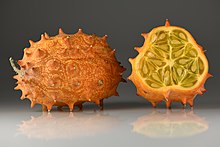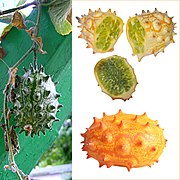
The papaya, papaw, or pawpaw is the plant species Carica papaya, one of the 21 accepted species in the genus Carica of the family Caricaceae. It was first domesticated in Mesoamerica, within modern-day southern Mexico and Central America. It is grown in several countries in regions with a tropical climate. In 2020, India produced 42% of the world's supply of papayas.

The cucumber is a widely-cultivated creeping vine plant in the family Cucurbitaceae that bears cylindrical to spherical fruits, which are used as culinary vegetables. Considered an annual plant, there are three main types of cucumber—slicing, pickling, and seedless—within which several cultivars have been created. The cucumber originates in Asia extending from India, Nepal, Bangladesh, China, and Northern Thailand, but now grows on most continents, and many different types of cucumber are grown commercially and traded on the global market. In North America, the term wild cucumber refers to plants in the genera Echinocystis and Marah, though the two are not closely related.

A melon is any of various plants of the family Cucurbitaceae with sweet, edible, and fleshy fruit. The word "melon" can refer to either the plant or specifically to the fruit. Botanically, a melon is a kind of berry, specifically a "pepo". The word melon derives from Latin melopepo, which is the latinization of the Greek μηλοπέπων (mēlopepōn), meaning "melon", itself a compound of μῆλον (mēlon), "apple", treefruit " and πέπων (pepōn), amongst others "a kind of gourd or melon". Many different cultivars have been produced, particularly of cantaloupes.
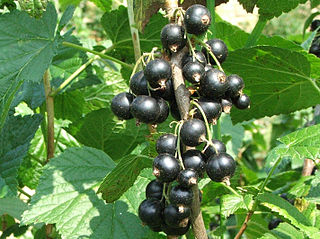
The blackcurrant, also known as black currant or cassis, is a deciduous shrub in the family Grossulariaceae grown for its edible berries. It is native to temperate parts of central and northern Europe and northern Asia, where it prefers damp fertile soils. It is widely cultivated both commercially and domestically.

Powdery mildew is a fungal disease that affects a wide range of plants. Powdery mildew diseases are caused by many different species of ascomycete fungi in the order Erysiphales. Powdery mildew is one of the easier plant diseases to identify, as its symptoms are quite distinctive. Infected plants display white powdery spots on the leaves and stems. The lower leaves are the most affected, but the mildew can appear on any above-ground part of the plant. As the disease progresses, the spots get larger and denser as large numbers of asexual spores are formed, and the mildew may spread up and down the length of the plant.

Fusarium wilt is a common vascular wilt fungal disease, exhibiting symptoms similar to Verticillium wilt. This disease has been investigated extensively since the early years of this century. The pathogen that causes Fusarium wilt is Fusarium oxysporum. The species is further divided into formae speciales based on host plant.

Downy mildew refers to any of several types of oomycete microbes that are obligate parasites of plants. Downy mildews exclusively belong to the Peronosporaceae family. In commercial agriculture, they are a particular problem for growers of crucifers, grapes and vegetables that grow on vines. The prime example is Peronospora farinosa featured in NCBI-Taxonomy and HYP3. This pathogen does not produce survival structures in the northern states of the United States, and overwinters as live mildew colonies in Gulf Coast states. It progresses northward with cucurbit production each spring. Yield loss associated with downy mildew is most likely related to soft rots that occur after plant canopies collapse and sunburn occurs on fruit. Cucurbit downy mildew only affects leaves of cucurbit plants.

Uncinula necator is a fungus that causes powdery mildew of grape. It is a common pathogen of Vitis species, including the wine grape, Vitis vinifera. The fungus is believed to have originated in North America. European varieties of Vitis vinifera are more or less susceptible to this fungus. Uncinula necator infects all green tissue on the grapevine, including leaves and young berries. It can cause crop loss and poor wine quality if untreated. The sexual stage of this pathogen requires free moisture to release ascospores from its cleistothecia in the spring. However, free moisture is not needed for secondary spread via conidia; high atmospheric humidity is sufficient. Its anamorph is called Oidium tuckeri.
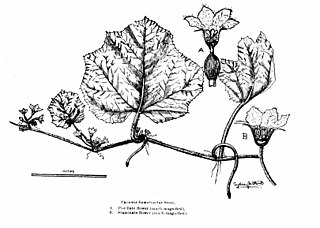
Cucumis humifructus, the aardvark cucumber or aardvark pumpkin, is a kind of cucumber from southern Africa, tropical Africa, and Madagascar which fruits underground. It is a prostrate vine up to seven meters in length. It is reliant on the aardvark to eat the fruit in order to spread and re-bury the seeds of the plant. The species was described in 1927, with the name spelled C. humofructus, but this is corrected to C. humifructus following the International Code of Nomenclature for algae, fungi, and plants.

Oidium mangiferae is a plant pathogen that infects mango trees causing powdery mildew. Powdery mildew of mango is an Ascomycete pathogen of the Erysiphales family that was initially described by Berthet in 1914, using samples collected from Brazil. O. mangiferae is found in all areas where mangoes have been raised long term, but is particularly widespread in India where both the host and the pathogen are native. Currently no teleomorph stage has been identified, but due to certain morphological characteristics it has been suggested that O. mangiferae belongs in the Erysiphe polygony group. Mango is the only known host for this pathogen, though O. mangiferae appears to be identical to fungi responsible for powdery mildew diseases on various other plant species, particularly oak, though some differences may be observed. In particular, the number of cells in conidiophores varies from 2 on mango to 3-5 on oak. O. mangiferae has been known to infect oak leaves in the laboratory, however due to the lack of a known teleomorph stage O. mangiferae is still considered to only be a pathogen of mango. Recent analysis of its ribosomal DNA suggests it is conspecific with Erysiphe alphitoides, the causative agent of powdery mildew in European oaks.
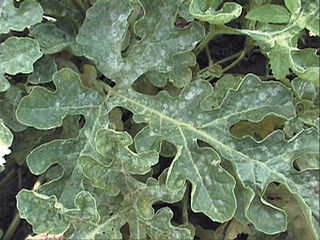
Podosphaera fuliginea is a plant pathogen that causes powdery mildew on cucurbits. Podosphaera fuliginea and Erysiphe cichoracearum are the two most commonly recorded fungi causing cucurbit powdery mildew. In the past, Erysiphe cichoracearum was considered to be the primary causal organism throughout most of the world. Today, Podosphaera fuliginea is more commonly reported.

Cucumber mosaic virus (CMV) is a plant pathogenic virus in the family Bromoviridae. This virus has a worldwide distribution and a very wide host range, having the reputation of the widest host range of any known plant virus. It can be transmitted from plant to plant both mechanically by sap and by aphids in a stylet-borne fashion. It can also be transmitted in seeds and by the parasitic weeds, Cuscuta sp. (dodder).

Melothria scabra, commonly known as the cucamelon, Mexican miniature watermelon, Mexican sour cucumber, Mexican sour gherkin, mouse melon, or pepquinos, is a species of flowering plant in the cucurbit family grown for its edible fruit. Its native range spans Mexico to Venezuela. Cucumis melo Agrestis and Cucumis callosus is cultivated as Chibber Fruit or Kachri in South Asia and can also grow as weed. Fruits are about the size of grapes and taste like cucumbers with a tinge of sourness. It may have been eaten by indigenous peoples before the European colonization of the Americas began.

Watermelon is a flowering plant species of the Cucurbitaceae family and the name of its edible fruit. A scrambling and trailing vine-like plant, it is a highly cultivated fruit worldwide, with more than 1,000 varieties.
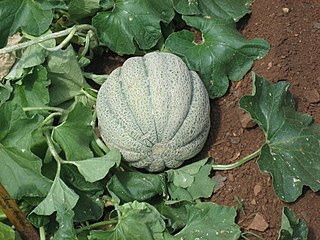
Cucumis melo, also known as melon, is a species of Cucumis that has been developed into many cultivated varieties. The fruit is a pepo. The flesh is either sweet or bland, with or without a musky aroma, and the rind can be smooth, ribbed, wrinkled, or netted. In North America, the sweet-flesh varieties are often collectively called muskmelon, including the musky netted-rind varieties and the inodorous smooth-rind varieties, and cantaloupe usually refers to the former type. However, muskmelon in a narrow sense only refers to the musky netted-rind type, also known as North American cantaloupe, while the true cantaloupe is the European type with ribbed and often warty rind that is seldom grown in North America.

Diabrotica balteata is a species of cucumber beetle in the family Chrysomelidae known commonly as the banded cucumber beetle. It occurs in the Americas, where its distribution extends from the United States to Colombia and Venezuela in South America. It is also present in Cuba. It is a pest of a variety of agricultural crops.
Gummy stem blight is a cucurbit-rot disease caused by the fungal plant pathogen Didymella bryoniae. Gummy stem blight can affect a host at any stage of growth in its development and affects all parts of the host including leaves, stems and fruits. Symptoms generally consist of circular dark tan lesions that blight the leaf, water soaked leaves, stem cankers, and gummy brown ooze that exudes from cankers, giving it the name gummy stem blight. Gummy stem blight reduces yields of edible cucurbits by devastating the vines and leaves and rotting the fruits. There are various methods to control gummy stem blight, including use of treated seed, crop rotation, using preventative fungicides, eradication of diseased material, and deep plowing previous debris.

The Indian Institute of Horticultural Research (IIHR) is an autonomous organization acting as a nodal agency for basic, strategic, anticipatory and applied research on various aspects of horticulture such as fruits, vegetable, ornamental, medicinal and aromatic plants and mushrooms in India. The institute has its headquarters in Bengaluru, Karnataka, India and is a subsidiary of Indian Council of Agricultural Research (ICAR), New Delhi, under the Ministry of Agriculture, India. It recently has been ranked 1st for the combined years 2019-20 and 2020-21 by the ICAR.

Melon necrotic spot virus (MNSV) is a virus that belongs to the genus Gammacarmovirus of the family Tombusviridae. It has been observed in several countries of the Americas, Africa, Asia, and Europe. It is considered to be an endemic virus in greenhouses and field productions of Cucurbitaceae crops, including melon, cucumber, and watermelon. MNSV is mainly spread through infected soil, seedlings, insects, and by the root-inhabiting fungus vector Olpidium bornovanus. Symptoms vary between Curbitaceae crops, but generally consist of chlorosis, brown necrotic lesions, leaf wilt, fruit decay, and plant death. Management of the disease consists of preventing infection by rotating fields and crops, steam sterilization, and disposal of infected plants. Also, treated seeds with heat or chemicals are efficient in preventing infection. MNSV is important in melon plants as it causes vast economical damage worldwide reducing significant yields.
Cucumis hystrix is a monoecious annual climbing vine in the family Cucurbitaceae. The specific epithet is Neo-Latin for "porcupine".
